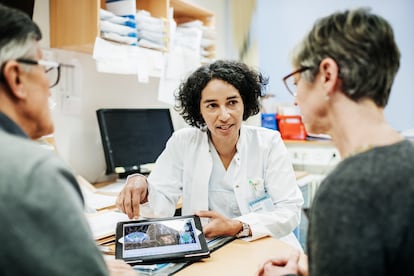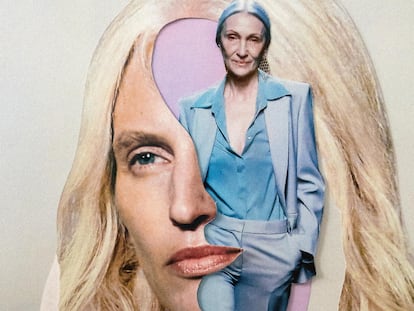Ageism, a type of discrimination that can lead to poor health and social isolation
One in three Europeans claims to have been the target of age-related stereotypes. The practice weighs most heavily on the elderly and even has an impact on the treatment they receive from doctors

Inside a doctor’s office, a physician addresses the patient’s adult children instead of the patient, to explain the care that he or she requires. The children, in turn, speak condescendingly to their relative, in a childish tone that is indistinguishable from the one they would use with a small child. This type of scenario plays out often, according to Vânia de la Fuente-Núñez, an expert in healthy aging. And it has a name: ageism. It involves how people act, feel and think about others (or themselves) based on their age (which does not have to be advanced). Numerous studies have found that these stereotypes, and the prejudices and discrimination that they entail, directly harm the health of those who suffer them.
De la Fuente-Núñez, who was responsible for the World Health Organization (WHO)’s campaign against ageism, believes that it is a public health problem, just like tobacco. “We can all suffer it, because we are all a certain age. And even if you are doing it unconsciously, or even if you believe that this behavior is beneficial for the other person, well it isn’t, it’s detrimental to them,” she said at a recent symposium organized by the Spanish Society of Epidemiology at the Carlos III Health Institute (ISCIII) in Madrid.
A WHO report on the subject published in 2021 showed that in Europe, one in three people report having been a target of ageism. Not only does it occur among older persons: young people can suffer from it as well. In fact, the highest levels of ageism reported among employees occur in the first years of one’s working life and in those prior to retirement. “Some are underestimated due to their lack of experience and others are considered too old,” explains De la Fuente. In all age groups, there are more people in Europe who report ageism than sexism or racism, and the group that feels it most keenly are those between 15 and 24 years old (nearly 50%); for other age groups, it is between 30% and 35%.
The health of the elderly is, however, the most affected by ageist behavior. At least, there is more scientific evidence about it. De la Fuente-Núñez also underscores the relevance of “self-inflicted ageism” that develops throughout one’s life. “At the age of four, we are already aware of the age-related stereotypes that exist in our culture,” she explains. These are internalized and used to guide feelings and actions towards other people. And, when you reach a certain age, you begin to apply it to yourself, so that these stereotypes end up being self-fulfilling prophecies.
“You can internalize a stereotype that an older person, for example, is not creative. So when you end up reaching old age, you act accordingly and maybe not pursue a dream that you had, like learning to play an instrument. Those self-fulfilling prophecies have a very negative impact on our health,” notes De la Fuente-Núñez.
One classic stereotype around old age is poor health. “If it is believed that the normal thing is to get sick at a certain age, perhaps a person will neglect their health when they reach it, fail to take the prescribed medications, refuse to quit smoking or do physical activity. Because, the theory goes, I’m old and going to get sick all the same...” says De la Fuente-Núñez.
Ageism also contributes to social isolation and loneliness, which are clearly linked to poorer health and shorter life spans. “This arises through different mechanisms. You can feel unwanted in old age and this can cause a withdrawal. You can also internalize that old age is a period of loneliness and isolation and act accordingly. And finally, there are ageist laws and social practices, such as removing the elderly from their homes to take them to senior care residences, which are usually far from urban centers.”
Often enough, it is doctors themselves who treat patients differently based on their age and not their health. According to the WHO Global Report on Ageism, “in health care, decisions regarding whether or not to withhold life sustaining therapies (e.g. ventilator support, surgery or dialysis) often vary by age, contributing to different outcomes for different age groups.” This correlation is shown in 85% of the studies that analyzed this association.
Sexual health and clinical trials
Ageism also affects the sexual health of the elderly. A study published in 2017 surveyed two groups of patients: one made up of 28-year-old patients and the other of 78-year-olds. In both cases, the patients were described as suffering from occasional erectile dysfunction with a clear psychosocial element. Despite having the same characteristics, most of the older ones were attributed to hormonal changes, while the younger ones were diagnosed with what is known as an anxiety problem related to the fear of not being up to the task in the sexual act. Without other tests to support this theory, the 78-year-old group received many more prescriptions for hormone therapy.
The diagnoses of sexual diseases also tend to be made later for older people. This has to do, in De la Fuente’s opinion, with the fact that older people have never had a sexual education nor are they the target of campaigns, which are often directed at young people. “If a person is widowed, has sex, goes to the doctor with a problem, he or she may assume that there is no sexuality in old age, so they do not ask pertinent questions.” This is causing delays in the detection and treatment of people with HIV, for example.
One of the biggest paradoxes regarding ageism and health occurs in clinical trials. According to the WHO report, the elderly are often excluded from these trials, despite the fact that the drugs will be consumed mainly by this age group, as is the case with medication for Parkinson’s or for heart disease. Older people are ruled out from volunteer trials because of their age and for having multiple conditions, something that studies try to avoid. “The problem is that these drugs will be taken by people with multiple conditions, so we should know how they act on them [before approving them],” De la Fuente notes.
Ageism remains understudied, but in recent years, interest in the subject has expanded and publications have grown exponentially. “Now we know that it can be prevented,” says this expert, underscoring the “high price” for people and society: “It can increase the risk of poverty and financial insecurity, it has implications for sick leave, days of absence and forced retirement and have an economic impact on health systems.”
Sign up for our weekly newsletter to get more English-language news coverage from EL PAÍS USA Edition
Tu suscripción se está usando en otro dispositivo
¿Quieres añadir otro usuario a tu suscripción?
Si continúas leyendo en este dispositivo, no se podrá leer en el otro.
FlechaTu suscripción se está usando en otro dispositivo y solo puedes acceder a EL PAÍS desde un dispositivo a la vez.
Si quieres compartir tu cuenta, cambia tu suscripción a la modalidad Premium, así podrás añadir otro usuario. Cada uno accederá con su propia cuenta de email, lo que os permitirá personalizar vuestra experiencia en EL PAÍS.
¿Tienes una suscripción de empresa? Accede aquí para contratar más cuentas.
En el caso de no saber quién está usando tu cuenta, te recomendamos cambiar tu contraseña aquí.
Si decides continuar compartiendo tu cuenta, este mensaje se mostrará en tu dispositivo y en el de la otra persona que está usando tu cuenta de forma indefinida, afectando a tu experiencia de lectura. Puedes consultar aquí los términos y condiciones de la suscripción digital.
More information
Últimas noticias
Daytime, headphones, no booze involved: How a generation is saying ‘no’ to club parties
Millennia-old Yuracaré language resists extinction through 900 speakers and a new dictionary
Susan Boyle prepares a comeback just as Timothée Chalamet sings her praises
Trump suspends green card visa lottery after shooting at Brown University
Most viewed
- Christian Louboutin: ‘Young people don’t want to be like their parents. And if their parents wear sneakers, they’re going to look for something else’
- Cartels in Mexico take a leap forward with narco-drones: ‘It is criminal groups that are leading the innovation race’
- Liset Menéndez de la Prida, neuroscientist: ‘It’s not normal to constantly seek pleasure; it’s important to be bored, to be calm’
- ‘El Limones’ and the growing union disguise of Mexican organized crime
- The low-cost creative revolution: How technology is making art accessible to everyone











































